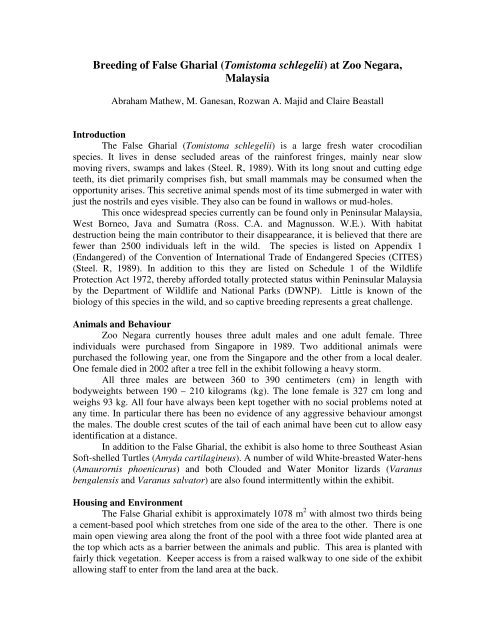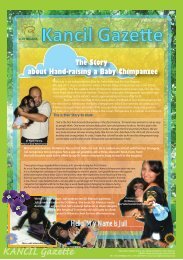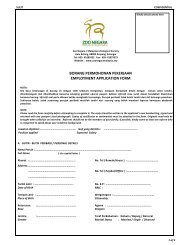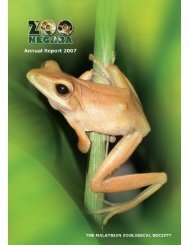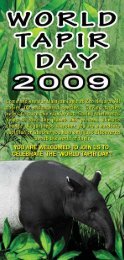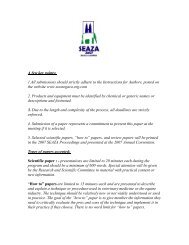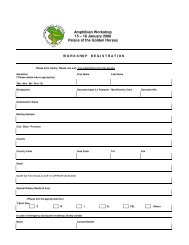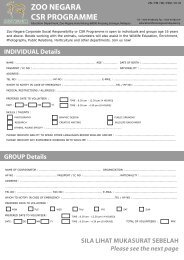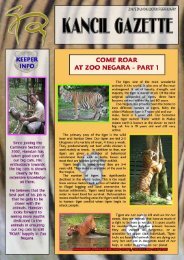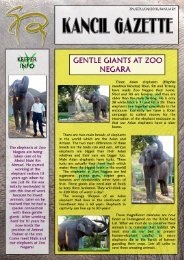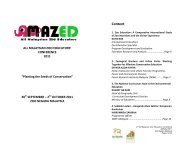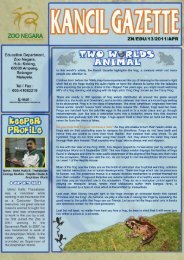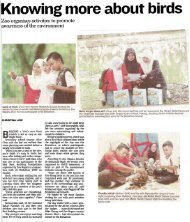Breeding of False Gharial (Tomistoma schlegelii) at Zoo Negara ...
Breeding of False Gharial (Tomistoma schlegelii) at Zoo Negara ...
Breeding of False Gharial (Tomistoma schlegelii) at Zoo Negara ...
Create successful ePaper yourself
Turn your PDF publications into a flip-book with our unique Google optimized e-Paper software.
<strong>Breeding</strong> <strong>of</strong> <strong>False</strong> <strong>Gharial</strong> (<strong>Tomistoma</strong> <strong>schlegelii</strong>) <strong>at</strong> <strong>Zoo</strong> <strong>Negara</strong>,<br />
Malaysia<br />
Abraham M<strong>at</strong>hew, M. Ganesan, Rozwan A. Majid and Claire Beastall<br />
Introduction<br />
The <strong>False</strong> <strong>Gharial</strong> (<strong>Tomistoma</strong> <strong>schlegelii</strong>) is a large fresh w<strong>at</strong>er crocodilian<br />
species. It lives in dense secluded areas <strong>of</strong> the rainforest fringes, mainly near slow<br />
moving rivers, swamps and lakes (Steel. R, 1989). With its long snout and cutting edge<br />
teeth, its diet primarily comprises fish, but small mammals may be consumed when the<br />
opportunity arises. This secretive animal spends most <strong>of</strong> its time submerged in w<strong>at</strong>er with<br />
just the nostrils and eyes visible. They also can be found in wallows or mud-holes.<br />
This once widespread species currently can be found only in Peninsular Malaysia,<br />
West Borneo, Java and Sum<strong>at</strong>ra (Ross. C.A. and Magnusson. W.E.). With habit<strong>at</strong><br />
destruction being the main contributor to their disappearance, it is believed th<strong>at</strong> there are<br />
fewer than 2500 individuals left in the wild. The species is listed on Appendix 1<br />
(Endangered) <strong>of</strong> the Convention <strong>of</strong> Intern<strong>at</strong>ional Trade <strong>of</strong> Endangered Species (CITES)<br />
(Steel. R, 1989). In addition to this they are listed on Schedule 1 <strong>of</strong> the Wildlife<br />
Protection Act 1972, thereby afforded totally protected st<strong>at</strong>us within Peninsular Malaysia<br />
by the Department <strong>of</strong> Wildlife and N<strong>at</strong>ional Parks (DWNP). Little is known <strong>of</strong> the<br />
biology <strong>of</strong> this species in the wild, and so captive breeding represents a gre<strong>at</strong> challenge.<br />
Animals and Behaviour<br />
<strong>Zoo</strong> <strong>Negara</strong> currently houses three adult males and one adult female. Three<br />
individuals were purchased from Singapore in 1989. Two additional animals were<br />
purchased the following year, one from the Singapore and the other from a local dealer.<br />
One female died in 2002 after a tree fell in the exhibit following a heavy storm.<br />
All three males are between 360 to 390 centimeters (cm) in length with<br />
bodyweights between 190 – 210 kilograms (kg). The lone female is 327 cm long and<br />
weighs 93 kg. All four have always been kept together with no social problems noted <strong>at</strong><br />
any time. In particular there has been no evidence <strong>of</strong> any aggressive behaviour amongst<br />
the males. The double crest scutes <strong>of</strong> the tail <strong>of</strong> each animal have been cut to allow easy<br />
identific<strong>at</strong>ion <strong>at</strong> a distance.<br />
In addition to the <strong>False</strong> <strong>Gharial</strong>, the exhibit is also home to three Southeast Asian<br />
S<strong>of</strong>t-shelled Turtles (Amyda cartilagineus). A number <strong>of</strong> wild White-breasted W<strong>at</strong>er-hens<br />
(Amaurornis phoenicurus) and both Clouded and W<strong>at</strong>er Monitor lizards (Varanus<br />
bengalensis and Varanus salv<strong>at</strong>or) are also found intermittently within the exhibit.<br />
Housing and Environment<br />
The <strong>False</strong> <strong>Gharial</strong> exhibit is approxim<strong>at</strong>ely 1078 m 2 with almost two thirds being<br />
a cement-based pool which stretches from one side <strong>of</strong> the area to the other. There is one<br />
main open viewing area along the front <strong>of</strong> the pool with a three foot wide planted area <strong>at</strong><br />
the top which acts as a barrier between the animals and public. This area is planted with<br />
fairly thick veget<strong>at</strong>ion. Keeper access is from a raised walkway to one side <strong>of</strong> the exhibit<br />
allowing staff to enter from the land area <strong>at</strong> the back.
The substr<strong>at</strong>e is a mixture <strong>of</strong> pe<strong>at</strong> and sand which has been well planted with<br />
shrubs and tall trees. There is also a mud hole big enough for all four <strong>False</strong> <strong>Gharial</strong>s to<br />
wallow in <strong>at</strong> any one time. This mud wallow was previously a cement-based tre<strong>at</strong>ment<br />
pond which allowed animals to be isol<strong>at</strong>ed when necessary. This was l<strong>at</strong>er converted to<br />
address the behavioural needs <strong>of</strong> the species. Additional basking areas, in which the<br />
animals are exposed to direct sunlight, can be found around the edges <strong>of</strong> the pool.<br />
However, it must be noted th<strong>at</strong> basking has rarely been observed in these animals.<br />
The pool is rel<strong>at</strong>ively straight along the front, whilst the back <strong>of</strong> the pool (<strong>at</strong> the<br />
rear <strong>of</strong> the exhibit) is irregular in shape providing visual barriers which possibly lessen<br />
the likelihood <strong>of</strong> social or behavioural conflict among the animals. The shallow end <strong>of</strong><br />
the pool is only 30 cm deep with a gradual slope down to 90 cm <strong>at</strong> the deepest point. The<br />
pool is filled with n<strong>at</strong>ural river w<strong>at</strong>er flowing through the zoo. During the day, the w<strong>at</strong>er<br />
flows <strong>at</strong> a slow constant r<strong>at</strong>e allowing a gradual r<strong>at</strong>e <strong>of</strong> daily w<strong>at</strong>er exchange. There are<br />
no filters used for the pool. The pool is cleaned out every two weeks or sooner if needed.<br />
Diets and Feeding<br />
The main diet <strong>of</strong> the <strong>False</strong> <strong>Gharial</strong> is fish. Individual animals are fed two to three<br />
kg <strong>of</strong> fish three times per week. In addition to this, they are also fed chicken, white r<strong>at</strong>s,<br />
guinea pigs and lean me<strong>at</strong> (beef) once every seven to fourteen days depending on<br />
availability. No vitamin and mineral supplements are added to the diet.<br />
Courtship and M<strong>at</strong>ing<br />
Courtship coincides with periods <strong>of</strong> rainfall (November to February and from<br />
April to June). The animals were noticeably more active during this period and the<br />
female was <strong>of</strong>ten seen with the largest male. The two other males positioned themselves<br />
<strong>at</strong> different inlets <strong>of</strong> the pool. However no m<strong>at</strong>ing was observed and it appears likely th<strong>at</strong><br />
this took place <strong>at</strong> night.<br />
Nest Construction and Laying<br />
Nest building started <strong>at</strong> the end <strong>of</strong> May just after the heavy rains. The nest mound<br />
was constructed just behind an area <strong>of</strong> thick undergrowth, directly under a tall Oil palm<br />
tree (Elaeis quineensis), approxim<strong>at</strong>ely six metres from the w<strong>at</strong>er’s edge. The female<br />
cleared 150 to 200 cm <strong>of</strong> undergrowth surrounding the nest site and th<strong>at</strong> cleared<br />
veget<strong>at</strong>ion was used by her for nest construction. Other substr<strong>at</strong>es used included pe<strong>at</strong>,<br />
twigs, small broken branches, oil palm seeds, parts <strong>of</strong> the palm leaf and frond and dried<br />
Banana (Musa sapeintum) leaves found by her in the exhibit. Additional Guinea<br />
(Panicum maximum) and Napier (Pennisetum purpureum) grass blades were placed close<br />
to the nest to use as extra nesting m<strong>at</strong>erial if required. Two weeks following the initial<br />
construction additional veget<strong>at</strong>ion was collected by the female and used to increase the<br />
height <strong>of</strong> the nest, suggesting th<strong>at</strong> egg laying took place around this time. The nest and<br />
eggs were not examined during this whole process for fear <strong>of</strong> disturbance.<br />
Nest and Eggs<br />
The nest mound was approxim<strong>at</strong>ely 45 to 50 cm high, with a diameter <strong>of</strong> 90 to<br />
110 cm. Examin<strong>at</strong>ion <strong>of</strong> the nest revealed th<strong>at</strong> the eggs were positioned just above<br />
ground level; each was marked and numbered. A total <strong>of</strong> 19 eggs were found, <strong>of</strong> which
only 11 were fertile. Three eggs were randomly selected for further examin<strong>at</strong>ion and their<br />
measurements are listed below (Table 1). These eggs were candled; revealing th<strong>at</strong> each<br />
was fertile. A plywood screen was held between the female and the nest throughout the<br />
collection <strong>of</strong> d<strong>at</strong>a. Although the female remained <strong>at</strong> the edge <strong>of</strong> the pool closest to the<br />
nest, no aggression was observed.<br />
Table 1.<br />
Egg No. Weight (gm) Length (cm) Width (cm)<br />
1 150 9.3 5.5<br />
2 155 9.0 5.5<br />
3 145 9.4 5.5<br />
Note: Egg dimensions were obtained two weeks after approxim<strong>at</strong>e d<strong>at</strong>e <strong>of</strong> laying.<br />
Random measurements <strong>of</strong> the nest temper<strong>at</strong>ure <strong>at</strong> egg level revealed a fluctu<strong>at</strong>ion<br />
between 26°C and 32°C, with lower temper<strong>at</strong>ures recorded following heavy rainfall. All<br />
the eggs were left in the nest for n<strong>at</strong>ural incub<strong>at</strong>ion which allowed for d<strong>at</strong>a collection.<br />
During the second month <strong>of</strong> incub<strong>at</strong>ion, one egg was removed and opened revealing a<br />
healthy, well formed embryo. Unfortun<strong>at</strong>ely, this died after two days despite being placed<br />
in an incub<strong>at</strong>or.<br />
H<strong>at</strong>chlings<br />
In September 2003, after approxim<strong>at</strong>ely 90 to 100 days <strong>of</strong> incub<strong>at</strong>ion, the<br />
h<strong>at</strong>chlings emerged from the nest. Much <strong>of</strong> the nest substr<strong>at</strong>e and veget<strong>at</strong>ion around the<br />
nest site had been cleared suggesting th<strong>at</strong> the female had assisted with the uncovering <strong>of</strong><br />
the nest. Seven <strong>of</strong> the eggs h<strong>at</strong>ched. Four h<strong>at</strong>chlings survived and are currently thriving;<br />
two <strong>of</strong> these were found in the w<strong>at</strong>er whilst all others were loc<strong>at</strong>ed on the land. Each <strong>of</strong><br />
those th<strong>at</strong> died was badly bitten by ants and termites found within the exhibit. We did not<br />
observe any <strong>at</strong>tempt by the female to aid the h<strong>at</strong>chlings into the w<strong>at</strong>er. No aggression<br />
was displayed towards the keepers when the h<strong>at</strong>chlings were collected, but the female<br />
remained close by. L<strong>at</strong>er examin<strong>at</strong>ion <strong>of</strong> the nest showed th<strong>at</strong> <strong>of</strong> the eggs which did not<br />
h<strong>at</strong>ch, eight were infertile and a further three eggs each contained fully formed embryos.<br />
The h<strong>at</strong>chlings were removed to prevent any danger <strong>of</strong> pred<strong>at</strong>ion from the adults, the<br />
Southeast Asian S<strong>of</strong>t-shelled Turtles and Monitor lizard species resident within the<br />
exhibit.<br />
Discussion<br />
The breeding <strong>of</strong> <strong>Tomistoma</strong> <strong>schlegelii</strong> <strong>at</strong> <strong>Zoo</strong> <strong>Negara</strong> marks the first captive<br />
breeding in Peninsular Malaysia. Few <strong>False</strong> <strong>Gharial</strong>s are currently held in captivity in the<br />
Peninsular and this fact, coupled with the lack <strong>of</strong> recent d<strong>at</strong>a available on the size <strong>of</strong> the<br />
wild popul<strong>at</strong>ion means th<strong>at</strong> captive breeding could play a vital role in the recovery <strong>of</strong> the<br />
species.<br />
Although the <strong>False</strong> <strong>Gharial</strong> has laid <strong>at</strong> <strong>Zoo</strong> <strong>Negara</strong> once in 1998, no nest building<br />
took place and the clutch was laid in the w<strong>at</strong>er. In an effort to understand the reasons for<br />
our first successful breeding <strong>of</strong> this species, we compared the ways in which these<br />
animals had been kept in the past with our current husbandry practices. It is possible th<strong>at</strong>
one or a combin<strong>at</strong>ion <strong>of</strong> some or all <strong>of</strong> these changes have contributed to this first<br />
success.<br />
During the last 13 to 15 years, <strong>Zoo</strong> <strong>Negara</strong> displayed five animals with a sex r<strong>at</strong>io<br />
<strong>of</strong> three males and two females, no signs <strong>of</strong> courtship or aggression have been seen in the<br />
past although based on size, all <strong>of</strong> the animals were sexually m<strong>at</strong>ure. Courtship was first<br />
noticed early in the year 2003 by which time the sex r<strong>at</strong>io was three males to only one<br />
female following the de<strong>at</strong>h <strong>of</strong> the other female in 2002. It is possible th<strong>at</strong> females kept in<br />
close proximity may suppress the breeding <strong>of</strong> one other. In addition, it must be noted th<strong>at</strong><br />
although <strong>Zoo</strong> <strong>Negara</strong> keeps males <strong>of</strong> almost equal size, there has been no aggression<br />
causing displacement <strong>of</strong> territory within the pool and the exhibit. All three males are able<br />
to congreg<strong>at</strong>e <strong>at</strong> the deepest loop <strong>of</strong> the pool and the wallow <strong>at</strong> the same time.<br />
The concept <strong>of</strong> the exhibit was altered after 2002 when changes were made to the<br />
maintenance routine in an <strong>at</strong>tempt to better meet the needs <strong>of</strong> the animals housed within.<br />
Before this, the exhibit was always kept trimmed and devoid <strong>of</strong> ground cover to allow a<br />
clear view <strong>of</strong> the animals for the public. Changes included an increase in the planting<br />
with extra veget<strong>at</strong>ion and wild shrubs being planted. In addition to this, a decision was<br />
made to cease the trimming <strong>of</strong> plants and undergrowth, providing a much more secluded<br />
area and a more varied choice <strong>of</strong> substr<strong>at</strong>e for nest construction. We believe th<strong>at</strong> the<br />
female was probably more comfortable building the nest in this less disturbed and more<br />
secluded area.<br />
In addition to these changes, the diet was altered after 2002. Prior to this, the<br />
animals were fed only on fish. We believe th<strong>at</strong> the variety <strong>of</strong> whole diet feeds provided to<br />
the animals, also contributed to the subsequent breeding success. It is possible th<strong>at</strong> a more<br />
varied diet allowed the animals to acquire the essential nutrients for fertility, egg<br />
development and laying.<br />
This first captive breeding success in the Peninsular has been a gre<strong>at</strong><br />
encouragement for further propag<strong>at</strong>ion <strong>of</strong> <strong>Tomistoma</strong> <strong>schlegelii</strong>. In view <strong>of</strong> this, we hope<br />
to get a gre<strong>at</strong>er understanding <strong>of</strong> the species not only in captivity but more importantly in<br />
the wild. The future <strong>of</strong> this beautiful crocodilian species may well depend on this.<br />
References<br />
1. Charles A. Ross and William Ernest Magnusson. Living Crocodilians, Crocodiles and<br />
Allig<strong>at</strong>ors. Facts On File, Weldon Owen Pty Limited, United St<strong>at</strong>es.<br />
2. Rodney Steel, 1989. Crocodiles. Christopher Helm Ltd.


